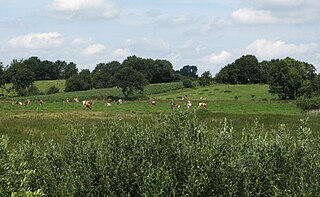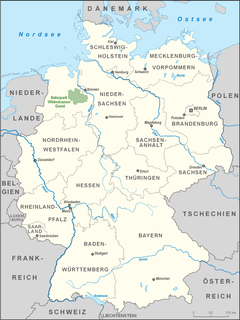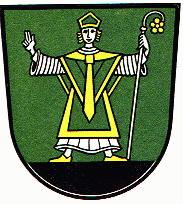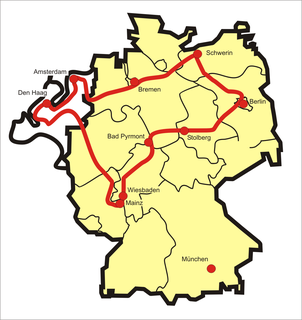
Lower Saxony is a German state (Land) situated in northwestern Germany. It is the second-largest state by land area, being larger than Denmark or the Netherlands with 47,624 km2 (18,388 sq mi), and fourth-largest in population among the 16 Länder federated as the Federal Republic of Germany. In rural areas, Northern Low Saxon and Saterland Frisian are still spoken, but the number of speakers is declining.

The North European Plain, is a geomorphological region in Europe, mostly in Poland, Denmark, Germany, Belgium, the Netherlands, with small parts of northern France and the Czech Republic.

Hunte is a 189-kilometre (117 mi) long river in north-western Germany, a left tributary of the Weser.
Northern Germany is the region in the northern part of Germany, whose exact area is not precisely or consistently defined. It varies depending on whether one has a linguistic, geographic, socio-cultural or historic standpoint. The five coastal states are regularly referred to as Northern Germany. Though geographically in the northern half of Germany, Westphalia, Brandenburg, and the northern parts of Saxony-Anhalt are rarely referred to as Northern Germany and instead are almost always associated with Western Germany and Eastern Germany respectively.

Geest is a type of landform, slightly raised above the surrounding countryside, that occurs on the plains of Northern Germany, the Northern Netherlands and Denmark. It is a landscape of sandy and gravelly soils formed as a glacial outwash plain and now usually mantled by a heathland vegetation on the glacial deposits left behind after the last ice age during the Pleistocene epoch.

This division of Germany into major natural regions takes account primarily of geomorphological, geological, hydrological, and pedological criteria in order to divide the country into large, physical units with a common geographical basis. Political boundaries play no part in this, apart from defining the national border.

The Schleswig-Holstein Uplands or Schleswig-Holstein Morainic Uplands is one of the three landscapes of the German state of Schleswig-Holstein; the others being the marsch and the geest. In addition, the gently rolling hills or Hügelland of the Baltic Uplands, the many small lakes and the long, deep embayments (Förde) formed by the moraines of the Weichselian Ice Age are characteristic features of the area. Its best-known towns are Kiel, Lübeck and Flensburg. The highest elevation in the area is the Bungsberg in the region known as Holstein Switzerland. On the Bungsberg is the only ski lift in the state.

The region between the Elbe and Weser rivers forms the Elbe–Weser triangle, also rendered Elbe-Weser Triangle, in northern Germany. It is also colloquially referred to as the Nasses Dreieck or "wet triangle".

The Lauenburg Lakes Nature Park was founded in 1961 and lies in the district of Lauenburg in the southeastern part of the German state of Schleswig-Holstein. It is right on the border with the state of Mecklenburg-Vorpommern in the Schleswig-Holstein Uplands, a Young Drift moraine landscape that formed during the Weichselian glaciation of the last ice age.

The Baltic Uplands is a chain of morainic hills about 200 kilometres (120 mi) wide that border the southern Baltic Sea from Jutland to Estonia.

The Wildeshausen Geest is part of the northwest Germany's geest ridge, that begins near Meppen on the river Ems with the Hümmling, is broken by the Weser depression, continues with the Osterholz Geest and reaches the marshes of Kehdingen by the river Elbe with the ridges of the Wingst and Stade Geest. It gives its name to the eponymous nature park.

The Weser Depression or Weser Lowlands is the region north of Porta Westfalica in Germany, where the River Weser no longer flows through a valley, but a broad plain consisting of meadows and river terraces.

Land Hadeln is a historic landscape and former administrative district in Northern Germany with its seat in Otterndorf on the Lower Elbe, the lower reaches of the River Elbe, in the Elbe-Weser Triangle between the estuaries of the Elbe and Weser.

The Orange Route is a holiday route, that runs from Amsterdam in the Netherlands through North and Central Germany and returns to Amsterdam. It is 2,400 kilometres long and crosses the Netherlands and nine of German federated states. The Orange Route runs through towns and regions that linked the House of Orange-Nassau for centuries.
The Wesermünde Geest is the collective name for several geest ridges in the west of Cuxhaven district and Bremen's North Borough in northern Germany. The ridges are separated from one another by wetlands. These terminal moraines were formed during the Saale glaciation, are up to between 10 to 70 m above sea level (NN), and are covered by scattered woods and farmland. The wetland areas, between 0 to 5 m above sea level, are predominantly used for grazing.
Großes Moor may refer to:
The Dümmer Geest Lowland is a natural region unit of the 3rd level in northwest Germany that mainly extends over southwestern Lower Saxony with a small area over the border in North Rhine-Westphalia. Its uniqueness consists in the very varied juxtaposition of different landscape elements of the Northern Lowlands of which the Dümmer Geest Lowland is a part.
Hügelland is a type of landscape consisting of low rolling hills whose topography or surface structure lies between that of a lowland region and that of a more rugged hill range or low mountain range. The term is German and has no exact equivalent in English, but is often translated as "hill country", "hilly terrain", "upland(s)" or "gently undulating" or "rolling country", or "rolling countryside". It is derived from Hügel, a low hill or hillock and appears frequently as a proper name for this type of terrain.
The Weser-Aller Plains and Geest is a natural regional unit of the North German Plain in Germany. It extends over most of the southern catchment of the Aller including the lower reaches of the Oker and Leine and is bounded in the west by the Middle Weser.















